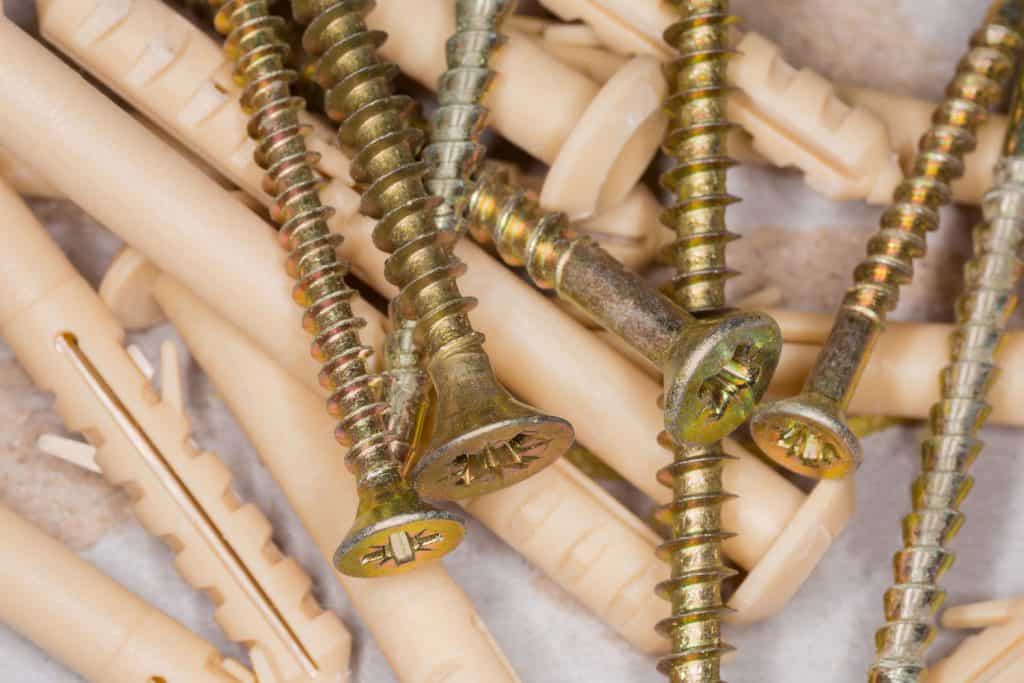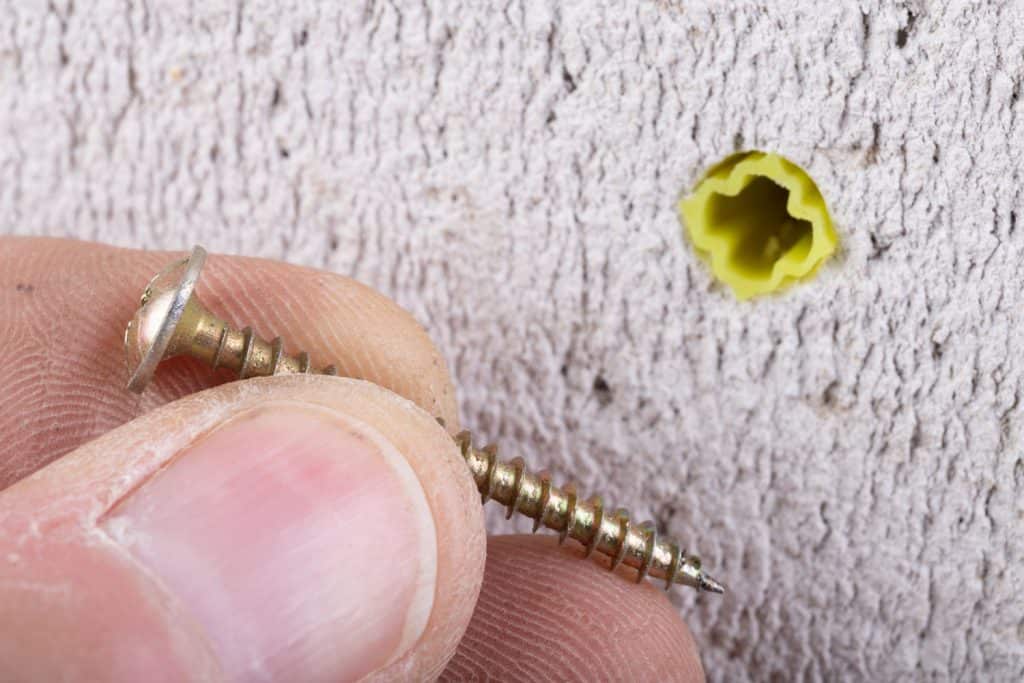How to Attach Wall Frame to Concrete Floor
Perhaps you are adding walls onto an existing concrete pad, or perhaps you are building a new home from the concrete foundation up. Either way, it is very important to securely attach the wood framing to the concrete element. So you are wisely wondering how best to fasten your wood framing to concrete. In this post, we gather research and experience to thoroughly answer your question.
There are several possible techniques for attached wood framing to concrete. However, they all require following these general steps.
- Choose a Method
- Choose a Fastener
- Layout Framing
- Affix Framing to Concrete
Read the rest of this post for details on each of the above steps. All told, we provide everything you need to know for attaching wood framing to concrete either vertically or horizontally. To conclude, we answer several questions related to this post's topic.
![Photo of a house under construction with visible wood framing of the wall and ceiling, How To Attach Wood Framing To Concrete [4 Steps To Follow]](https://homedecorbliss.com/wp-content/uploads/2021/05/How-To-Attach-Wood-Framing-To-Concrete-4-Steps-To-Follow-683x1024.png)
How do you secure a framed wall to concrete?
The most common situation where you need to secure wood framing to concrete involves pre-framed walls. For this reason, we will focus on securing framed walls to concrete as the main bulk of this post. However, the techniques described in this section apply to affixing any wood framing to concrete.
As you choose methods and fasteners as described below, keep local building code in mind. It is important to follow these rules should a building inspector come to examine your work. It is much easier to meet code the first time, though, than to be forced to re-work parts of your project.
Choose a Method
The first step is to choose the method you want to use to secure your framing to your concrete. For more extensive projects, it might be worth buying specialized tools. For smaller projects, using the more labor-intensive but simpler strategies suffice.
Methods include concrete nails pounded with a hammer, masonry screws, drop-in anchors, lag bolts, hammer-drive anchors, trigger shot tools, and using a steel track. We will cover each of these methods in the following sub-sections. All of the following options are commonly used to hold framing to concrete.
Concrete Nails
Concrete nails are hardened nails that are usually very tapered. These can be purchased at almost any home-improvement store. The biggest drawback to these nails is they take a lot of effort to drive and still may bend. Be careful as you pound the first nail through the framing because the framing will try to bounce out of place at each impact before the nail is set. Some concrete nails are untapered; for these, drill a pilot hole before pounding.

Click here for tapered concrete nails from Amazon.
If you do not have any of the other needed tools and only have a small piece of framing to affix to concrete, concrete nails are a good option. Be warned; if the concrete is over 1-year old, it has likely cured to a level of hardness to make the use of concrete nails too difficult.
Masonry Screws

Masonry screws are designed to hold in concrete and other masonry products. Generally, these require pre-drilling the holes with a roto-hammer and then driving the screws with an impact driver. It is possible to use a sparser set of drills than recommended here, an option that requires specialized bits and additional effort.

Click here for a masonry screw from Amazon.
Drill a pilot hole through the framing and into the concrete that is slightly narrower than the screw. The goal is for the threading of the screw to solidly bite into the concrete. Also, make sure you drill the hole a bit deeper than the screw is long.
The easiest technique is to mark the drill-bit with a piece of tape to give you a depth to aim for. Just hold the screw next to the bit to get a measurement. Sometimes, it is easiest to drill the bottom plate of the framing and the concrete with different bits -one for wood and one for concrete.
Once you have the pilot hole drilled, take the masonry screw and drill it all the way in. As mentioned above, an impact driver works easiest for this, but a regular screw gun can also suffice. Be sure not to overtighten the screw, as that has the danger of stripping the hole. After a few solid screws, you will get the hang of this.
Expansion Bolts
To install, drill a consistently sized hole through the framing and into the concrete, which is a little deeper than the bolt is long. Then, use a shop vac or blow-tube to clean out the hole. Pound the expansion bolt into the hole. For some expansion bolts, you will need to thread the nut onto the head of the bolt before pounding. Now, tighten the bolt with a ratchet wrench.

Click here for expansion bolts from Amazon.
The sleeve of the anchor is forced wider by the tightened bolt creating a very solid connection. Of all the fasteners described here, this one probably costs the most per hole. However, it is also the fastener that has the strongest potential and is thus appropriate for very heavy-duty applications.
Lag-Bolts
Lag bolts are heavy-duty screws. To install, pre-drill a hole with a roto-hammer through the framing and into the concrete. Make sure the hole is slightly smaller than the bolt so that the threads of the bolt bite into concrete material. As with masonry screws, be sure the hole is deeper than your bolt is long. Then, with a washer on the bolt, screw the bolt into the concrete using a ratchet wrench.

Click here for some appropriate lag bolts from Amazon.
Hammer-Drive Anchors
Hammer drive anchors use a similar technology to expansion bolts. This means that you need to pre-drill a hole that fits the hammer-drive anchor, and then clean the dust out of the hole. Now, tap the anchor into place. Once it is set, you can drive the nail the rest of the way in. The nail forces the base of the anchor wider, holding the hammer-drive anchor into place.

Click here for appropriate hammer-drive anchors from Amazon.
Trigger Shot Tool
Trigger shot tools use special nails and special gunpowder cartridges to fire the fastener through the framing and into the concrete. These tools are dangerous but take almost all of the effort out of this process. Usually, it is only worth investing in these narrow-use tools if you plan on affixing a lot of framing to concrete.

Click here for a trigger shot tool from Amazon.
Steel Track
Affixing a steel track that perfectly fits your framing is an alternative to driving the fasteners through the framing into the concrete. For this technique, use any of the above options but with much shorter fasteners. Usually, contractors pair hammer-drive anchors or masonry screws with steel tracks. This technique is less popular because it requires purchasing the expensive track.
Choose a Fastener
You will notice that for most of the above options, you can choose fasteners of different diameters and lengths. The larger the diameter and the longer the fastener, the better the holding power. If you are worried about supporting a particularly heavy wall, contact an architect or building professional for advice.
However, a general rule of thumb is that the fastener should go at least 1-inch into the concrete. So for affixing a 2×4 bottom-plate to concrete, you need at least a 2-1/2-inch fastener. This is 1-1/2-inch for the thickness of the 2×4, and another 1-inch into the concrete.
Layout Framing
Now that you have chosen a method and appropriate fasteners, it is time to get to the real work. It is essential to this step that you are very careful in layout out the framing. It is a pain to change the framing location once the lumber is affixed to the concrete.
Usually, builders will snap lines onto the concrete to make sure the wall is exactly the direction they want it. Then, they build the whole wall and tilt it up. Using scraps or extra pieces, they then ensure the wall is more or less plump and perfectly in line with their floor mark. Only then will they start to fasten the wall to the concrete.
Affix Framing to Concrete
Now that you have chosen a method, a fastener, and have carefully laid out and supported your framing, you can actually drive the fasteners through the framing into the concrete. Be sure to follow the local building code, but usually, it is recommended that you fasten the framing to the concrete at least every 16-inches. Putting fasteners closer than 10-inches apart can start to crack the concrete.
Should I use glue to attach my framing to the concrete?

Click here for high-strength epoxy from Amazon.
Many contractors draw a bead of high-powered glue along the bottom of the framing. This adds additional strength to the framing concrete joint. Generally, if you are using glue, you can use fasteners of a smaller diameter. Using glue will only strengthen your finished product.
How do you attach wood studs to concrete?

Generally, you never attach wood studs to concrete. This is because studs run vertically while concrete lays horizontally. Instead, people are generally in need of attaching bottom plates to concrete. The bottom plate is a board set on the ground that the studs stick up from.
Sometimes, you might have a small concrete wall that actually does run along a stud. If you want to attach that stud to the concrete, use any of the techniques described above.
How do you anchor a timber frame to concrete?
Attach timber framing to concrete with metal post brackets. These brackets come in a wide variety of makes and models. They include brackets that hug the four corners of the post and brackets that fit into a slot in the middle of the post.

Click here for the type of anchor used to anchor for timber framing to concrete from Amazon.
Talk to your local home improvement store to see what options are available in your area. As always, be sure to follow local building codes when anchoring your timber frame home to the concrete of your foundation.
How do you attach wood to concrete without drilling?
Two of the methods described above require no drilling. The first, using concrete nails, is very energy-intensive and difficult. It should only be attempted on concrete less than 1-year old. If you attempt this, be sure to buy high-quality nails and be ready to apply some elbow grease.
The second, using a trigger shot tool, takes the power of gunpowder to slam nails into your concrete. This technique uses a dangerous tool and specialized nails and powder cartridges. Follow the directions on the packages to avoid the need to drill or hammer.
In Closing
This post has provided step-by-step directions for affixing framing to concrete. We include an overview of all popular fastening techniques as well as what to look for in specific concrete fasteners. We also answered a few related questions. Good luck!
Have you chosen a decoration scheme for your new home or addition? Even if you have take a look at these two great articles to get some ideas, "15 Captivating Contemporary Decorating Ideas" and "Eclectic Home Decor: Step-By-Step Guide For Beginners."
How to Attach Wall Frame to Concrete Floor
Source: https://homedecorbliss.com/attach-wood-framing-to-concrete/
0 Response to "How to Attach Wall Frame to Concrete Floor"
Post a Comment